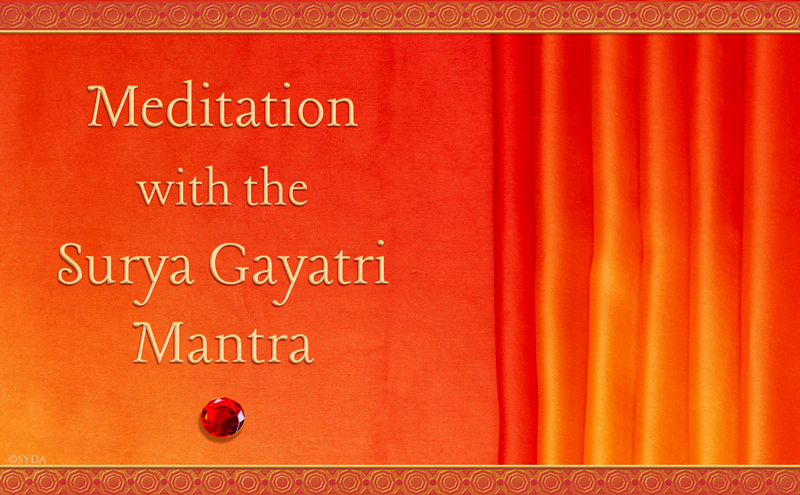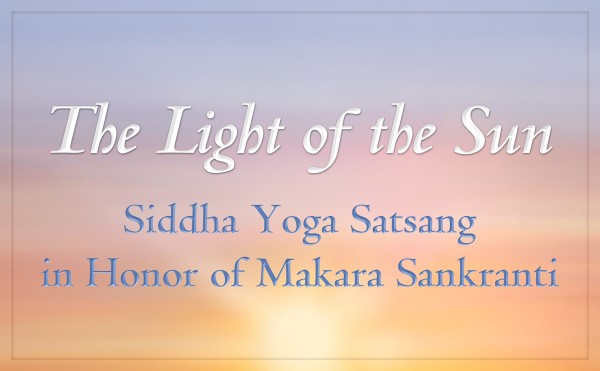
Last night, as worries about a situation arose, the syllables of the Surya Gayatri mantra began to vibrate inside me, and I spontaneously began to recite them. Gradually, my mind calmed down, and I heard inside, “There’s nothing you can do; you have to leave it up to God.” Peace filled my soul, and I quietly fell asleep.
This morning, I received a text saying that the situation had been resolved in an unexpected and happy way. I felt that Shri Guru had intervened, and I thought about how grateful I am for her unwavering love and support.
Vancouver, Canada
I was brought up reciting the Surya Gayatri mantra, and we recited this mantra during the sacred fire ceremonies that we held at our family home. Since I began my path to enlightenment with Gurumayi, this mantra has become alive and potent for me. What a blessed day to have recited the Surya Gayatri mantra with my beloved Gurumayi.
East Sussex, United Kingdom
As the sun sets over the ocean near where I live, it casts a divine golden glow. I’m able to look directly into its light and recite the Surya Gayatri mantra. As I do so, quite magically, the great ball of fire becomes small and glides into my consciousness. I am certain then that my insight is awakened.
Florida, United States
I prepare for each day by looking east as Lord Surya emerges from the sea. I recite the Surya Gayatri mantra while dancing like Lord Shiva as the sun rises from the ocean. I become full of gratitude, happiness, and love. This practice enlivens my meditation and my whole day.
Hawaii, United States
Today, as I meditated with the Surya Gayatri mantra, I felt a sense of spontaneous joy within. It felt like the sun’s rays were illuminating my inner head space. It was so beautiful.
After meditation, I decided to revisit Gurumayi’s Deepavali poem for 2025, “The Flame of Auspicious Intention.” As I did so, it felt like I was gaining a greater understanding of Gurumayi’s Message for 2026 and what I need to really work on in my sadhana. I am excited to continue to explore Gurumayi’s Message and go deeper on my spiritual path with the help of Shri Gurumayi’s blessings.
New York, United States
Mersin, Turkey
This year, before meditation I will pray to Surya Devata to help me practice Gurumayi’s Message.
Gurugram, India
In the comfort of my home, echoing this spectacle, I recited the Surya Gayatri mantra. Every Sanskrit syllable was crystal clear, reflecting the purity and silence of the winter atmosphere. I felt in communion and harmony with the universe.
Rodez, France
California, United States
I meditated with the Surya Gayatri mantra this morning. First I repeated it out loud and then silently to myself, while listening to its sweet melody. I was pulled inward and saw my whole body repeating the mantra. It seemed as if I was being drawn by the sound of the mantra toward the radiant light of the sun. This made my whole being feel pure and uplifted. After a time, everything became completely silent, and I entered into a deep meditation. Afterward, I felt tranquil and peaceful. I experienced a state of pure silence, which remained with me for quite a while.
Udaipur, India
Tokyo, Japan
I had a wondrous vision and a powerful vibration that expanded throughout my body. My thoughts dissolved completely, as never before. All that remained was sublime meditation.
San Giorgio a Cremano, Italy
Puerto Vallarta, Mexico
Nairobi, Kenya
For me, the Surya Gayatri mantra is like the key that unlocks the door to a golden, deep state of meditation.
St. Laurent, Canada









